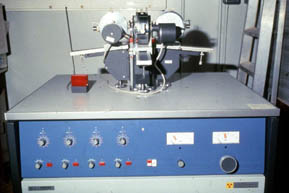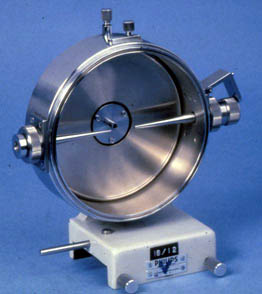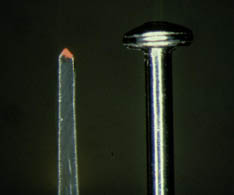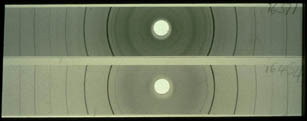‘Ubaid Plaster Technology at Dalma Island, Abu Dhabi emirate, United
Arab Emirates
by Dr.
Louise Joyner (Lecturer
in Conservation Science, Cardiff
School of History and Archaeology (HISAR), Cardiff
University, U.K.)
Date: 2001 (updated by Dr
Mark Beech, June 2004)
Summary
report
Gallery
Contact details
Related web links
‘Ubaid period plaster vessel and construction
material fragments from Dalma Island in the United Arab Emirates, have
been analysed scientifically to identify the types of plaster used.
The techniques used include optical
microscopy, X-ray
diffraction, energy dispersive X-ray microanalysis in the scanning
electron microscope and X-ray
fluorescence spectroscopy. Three types of material were used for
the vessels and construction materials: two are gypsum plasters, one
with quartz aggregate, the other an impure gypsum mixed with calcareous
clay and added limestone and quartz aggregate; the third type is lime-rich
with limestone aggregate. Both gypsum and calcareous materials are locally
available on Dalma Island. The plaster vessels were built up in layers,
sometimes using different plaster recipes for the different layers.
Some plaster vessels were decorated with black or pink pigments. Black
decoration was applied to the exterior surfaces of some plaster vessels
which appears to imitate the decorative patterns seen on ‘Ubaid pottery
imported from Mesopotamia. The black pigment contains manganese and
iron; it is uncertain if this pigment is locally available. A pink slip
applied to the exterior surface of a few vessels was made from a mixture
of finely ground hematite and gypsum, both of which are found locally
on Dalma Island.
(N.B. This work was carried
out when Dr Louise Joyner was formerly employed in the Department
of Scientific Research at
the British Museum.
This department is
now known as the Department of Conservation, Documentation and Science.).

Ubaid gypsum
plaster vessel fragments painted with a black pigment containing iron
and manganese from Dalma Island. The stripe and chevron patterns resemble
the decorative schemes seen on Ubaid imported pottery from Southern
Mesopotamia.
(click on image to view
a larger higher resolution picture - 64 kb)

The X-ray
diffraction generator fitted with Debye-Scherrer powder cameras that
was used for the mineralogical analysis of the Ubaid plasters, in the
Department of Scientific Research, The British Museum.
(click on image to view
a larger higher resolution picture - 68 kb)

A Debye-Scherrer
powder camera in which a sample of Ubaid plaster was analysed on the
X-ray diffraction generator in the Department of Scientific Research,
The British Museum
(click on image to view
a larger higher resolution picture - 44 kb)

A tiny sample
from one of the Dalma plaster vessel fragments is mounted at the end
of a gelatine stick. Note the pin head to indicate the scale
(click on image to view
a larger higher resolution picture - 31 kb)

Two X-ray
diffraction patterns produced on photographic film using the Debye-Scherrer
powder cameras on the X-ray diffraction generator.
(click on image to view
a larger higher resolution picture - 35 kb)
Contact Details:
Dr. Louise Joyner
Lecturer in Conservation Science
Cardiff School of History and Archaeology (HISAR)
Cardiff University
PO Box 909
Cardiff CF10 3XU
U.K.
Phone: +44 (0)29 2087 5157
Fax: +44 (0)29 2087 4929
Email: joynerl@Cardiff.ac.uk
Website: www.cardiff.ac.uk/hisar/people/archaeology/lj/
Related Links:
Archaeology
Abu Dhabi Islands Archaeological
Survey (ADIAS) website: www.adias-uae.com
including the following pages:
Archaeology of Dalma island
ADIAS Occasional Newsletter - May 2004 (which includes details of
the plaster vessel fragments discovered from the early 5th millennium
BC site of MR11 on Marawah
island)
Organisations
Abu Dhabi Islands Archaeological
Survey (ADIAS) website: www.adias-uae.com
British Museum website: http://www.thebritishmuseum.ac.uk
Department of Scientific Research (British Museum) website: http://www.thebritishmuseum.ac.uk/science
Scientific methods
optical microscopy:
http://www.thebritishmuseum.ac.uk/science/techniques/sr-tech-optical-mic.html
Scanning Electron Microscope:
http://www.thebritishmuseum.ac.uk/science/techniques/sr-tech-sem.html
X-Ray Diffraction: http://www.thebritishmuseum.ac.uk/science/techniques/sr-tech-xrd.html
X-Ray Fluorescence: http://www.thebritishmuseum.ac.uk/science/techniques/sr-tech-xrf.html
home
|





